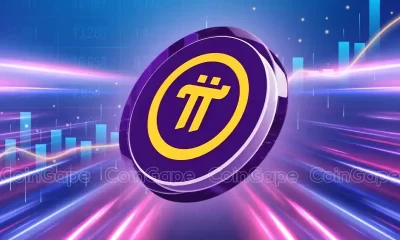Amboss
Amboss CEO Talks Growth Of The Bitcoin Lightning Network, Tether (USDT) On Lightning
Published
1 month agoon
By
admin
Founder: Jesse Shrader and Anthony Potdevin
Date Founded: March 2021
Location of Headquarters: Nashville, TN
Number of Employees: 10
Website: https://amboss.tech/
Public or Private? Private
Jesse Shrader thinks that this will be an important year for the Lightning Network.
With Bitcoin’s price on the rise and Tether (USDT) coming to Lightning, Shrader posits that more and more businesses and institutions will begin to see Lightning for payments in the year ahead.
And his company, Amboss, is poised to help make this vision a reality.
“We want to extend Bitcoin as a payment system and use Lightning to do that,” Shrader told Bitcoin Magazine. “We want to make Lightning a high-efficiency, high-performance system.
Through a suite of tools and services Shrader and the team at Amboss have developed, they are prepared to onboard the next wave of institutional users to the world’s largest permissionless payment network — especially now that USDT runs on Lightning.
What Amboss Does
Amboss primarily provides intelligent payment infrastructure for digital payments using the Lightning Network.
“We deliver insights to people regarding what they should do to increase efficiency of payments on the network,” said Shrader.
To accomplish this, they offer a number of products and services.
One of the most notable of these is Amboss Space, which is a Lightning Network explorer that employs machine learning to help users retrieve information on or connect to any node on the network.
Beyond their analytics software, Amboss also provides its customers with tools and services to help improve liquidity conditions on Lightning.
One such service is Magma Marketplace, which lets users buy and sell liquidity on the Lightning Network. Using Magma, users can provide liquidity — without giving up custody of their bitcoin — for a yield.
Another is Hydro, an extension of Magma. The software enables users to automate their liquidity purchases to better ensure the success of payments.
(And Amboss also offers Reflex, a compliance suite for business customers with AML (Anti-Money Laundering) reporting obligations.)
Amboss’ analytics software and tools are built for high-volume transactions, which are becoming easier to make on Lightning.
“We measure businesses’ ability to make payments with simulations,” explained Shrader. “We’ll help businesses see how much of the network can they actually reach when they attempt a payment.”
The State Of Lightning
Shrader is optimistic when it comes to the growth of Lightning. With each passing day, users are relying on the network to send more than just micropayments.
“We’ve been successfully processing everyday payments on Lightning, which I’m defining as between $10 and $4,000 payments,” said Shrader. “We’re working to enhance the network’s capabilities even further, with a focus on decentralization.”

Payments larger than $4,000 are still difficult to process. Shrader explained that more capital is needed to help make processing larger payments a reality.
However, he also noted that the recent increase in bitcoin’s price has helped larger payments to be processed more easily.
“What we saw recently is that the Bitcoin price has increased, which has increased the capability for settlement across all Lightning channels,” said Shrader. “Since the channels are bitcoin denominated, it’s like we got bigger pipes.”
And while Shrader is optimistic about these bigger pipes allowing for more throughput, he also believes that Tether (USDT)’s coming to Lightning will attract even more liquidity to the network.
Tether (USDT) On Lightning
At the end of last month, Lightning Labs announced that it’s bringing USDT to Bitcoin and the Lightning Network via the Taproot Assets protocol.
This upgrade enables Bitcoin service providers to integrate and accept USDT more easily, which Shrader believes will be a boon for Lightning.
“One thing that’s very clear is Tether has product market fit,” said Shrader.
“Last year, it served $10 trillion in payments, which exceeds Visa and MasterCard,” he added.
“It’s very clear that the world wants U.S. dollars.”
Shrader, a pragmatist, acknowledged the fact that many hardline Bitcoiners have issues with USDT running on Bitcoin and Lightning, and he sympathizes with them, as he appreciates that bitcoin’s sound money qualities.
At the same time, he thinks the benefits of having USDT on Lightning clearly outweigh the cons, as many still don’t understand what bitcoin is, nor are they willing to stomach its volatility.
“Many haven’t yet taken the orange pill and come to understand the advantages of bitcoin,” he explained.
“I think bitcoin is an incredible tool, and I want to bring that to as many people as possible. With that said, there are a lot of problems with traditional payments, and Bitcoin has this very secure, auditable system, which is something that I want to bring to the world at scale,” he added.
“While bitcoin’s price action is great for me, a lot of people are afraid of volatility. If you have an asset with very low volatility like USDT, now on very secure, trustless rails, that’s a huge win.”
The Problem That USDT On Lightning Solves
Shrader recounted how the first Bitcoin-related conference MicroStrategy hosted was actually called “Lightning for Corporations.” At the conference, companies were encouraged to start paying employees in bitcoin over Lightning — without fully realizing the troubles this would cause at the time.
“What employers realized was that all of the 1099s that needed to be submitted to employees was a hassle,” said Shrader. “And there was a whole bunch of regulatory overhead that they had to contend with, as well.”
Shrader pointed out that not only can paying employees in USDT over Lightning reduce accounting and regulatory headaches, but it also reduces some of the counterparty risk associated with using banks — a reality with which Shrader is quite familiar.
“Our payroll used to go through Silicon Valley Bank,” said Shrader.
“And, at one point, the payroll provider contacted me to resend my mid-month payroll after I had attempted to pay the staff. I lost half a month’s runway. This was all because of Silicon Valley Bank being insolvent,” he added.
“So, if I can avoid the counterparty risk in the financial system by moving to Bitcoin and Lightning, then that means that I’m in a much better place.”
[Author’s note: Some counterparty risk still exists when using USDT, as you have to trust that Tether holds actual U.S. dollars to back the tokenized ones it issues.]
The Risks
Shrader noted some of the risks of USDT on Bitcoin and Lightning, but didn’t seem too concerned about them.
“There are some MEV risks when you have assets other than a blockchain’s native asset being traded on-chain,” said Shrader. “But Bitcoin already has Ordinal inscriptions that create other assets, so that problem already exists.”
He also didn’t seem flustered when I brought up the risk of a Bitcoin fork resulting in the USDT on one of the chains becoming worthless, nor did he feel that there’s notable risk of larger economic nodes in the Bitcoin network, like Coinbase, which custodies the bitcoin for the U.S. spot bitcoin ETFs, opting to support a “Tether fork” of Bitcoin, which could also include other upgrades that could hurt Bitcoin in the long run.
“Bitcoin consensus is not determined by custody of bitcoin, so while an important business like Coinbase may support various changes or initiatives, that doesn’t guarantee that protocol changes would be effected,” Shrader said.
Instead of focusing on the risks associated with USDT on Bitcoin, Shrader is doing the opposite.
“What’s more interesting is probably the opportunities that that unlocks where you have actual arbitrage ability on Bitcoin itself,” said Shrader.
“Since every node is capable of transacting in both USDT and bitcoin is also capable of exchanging between them natively on Lightning, you can send bitcoin out of one Lightning channel and receive USDT in another of your Lightning channels,” he added.
“That can be as simple as generating a USDT invoice and paying it with BTC, instantly rebalancing holdings.”
2025: The Year Of Lightning
In Shrader’s final thoughts from my interview with him, he shared two last key reasons why 2025 will be the year of Lightning.
The first is that holding bitcoin is no longer required to use Lightning.
“Up until this year, if people or businesses wanted to switch to Lightning, they needed to have bitcoin first — and that’s a huge barrier,” explained Shrader. (Shrader added in a response to a follow-up question that, outside of the U.S., it’s relatively easy and common to get access to USDT.)
“The bitcoin-only market for payment processing is tiny. But this year we’ve removed that barrier, and consumers can pay with another asset — USDT. There’s already a large market for that,” he added.
(Shrader also noted that while USDT is running on Lightning rails, bitcoin still benefits, as the USDT is converted into bitcoin as it travels across Lightning. He added that “all that bitcoin sloshing around on Lightning makes it more rewarding to run a Lightning node.”)
What is more, Shrader noted that Lightning users will only pay a small fraction of what they had been paying in transaction fees using the traditional financial rails.
“We’re supplying liquidity at less than 0.5%,” said Shrader.
“As a user of big payment card networks, I’m paying 4% for all that payment processing, and the money doesn’t show up for days to weeks after the payment is made,” he added.
“With Lightning, your payment processing fees drop by almost 10x.”
Given Shrader’s points, it’s hard to imagine that 2025 won’t be a big year for Lightning.
Source link
You may like


Kraken Secures Restricted Dealer Status in Canada Amid 'Turning Point' for Crypto in the Country


Binance Sidelines Pi Network Again In Vote To List Initiative, Here’s All


XRP Price Reversal Toward $3.5 In The Works With Short And Long-Term Targets Revealed


Former New York governor advised OKX over $505M federal probe: Report


First Digital USD (FDUSD) Depegs After Justin Sun Alleges Firm Is ‘Insolvent’ and Not Fulfilling Redemptions


Gen Z’s Bitcoin Bet, The Largest Wealth Transfer In History?

Kraken Secures Restricted Dealer Status in Canada Amid 'Turning Point' for Crypto in the Country

Binance Sidelines Pi Network Again In Vote To List Initiative, Here’s All

XRP Price Reversal Toward $3.5 In The Works With Short And Long-Term Targets Revealed

Former New York governor advised OKX over $505M federal probe: Report

First Digital USD (FDUSD) Depegs After Justin Sun Alleges Firm Is ‘Insolvent’ and Not Fulfilling Redemptions

Gen Z’s Bitcoin Bet, The Largest Wealth Transfer In History?

Trump’s Crypto Conflicts Dominate Stablecoin Legislation Debate

First Digital denies allegations, threatens legal action

Crypto Firm Galaxy Secures UK FCA Approval for License to Expand Derivatives Trading

Why Is The Bitcoin Price Surging Today?

Cardano Founder Reveals What Will Onboard 3 Billion New Users Into Crypto

Sentient open-source AI search outperforms GPT-4o and Perplexity

Memecoin Collapse Creates Perfect Moment for TradFi To Launch ‘Trusted Assets,’ According to Chris Burniske

Breez Announces Launch Of New Wallet, Misty Breez

Alabama, Minnesota Advance Bitcoin Reserve Plans With Companion Bills

Arthur Hayes, Murad’s Prediction For Meme Coins, AI & DeFi Coins For 2025

Expert Sees Bitcoin Dipping To $50K While Bullish Signs Persist

Aptos Leverages Chainlink To Enhance Scalability and Data Access

Bitcoin Could Rally to $80,000 on the Eve of US Elections

Sonic Now ‘Golden Standard’ of Layer-2s After Scaling Transactions to 16,000+ per Second, Says Andre Cronje

Crypto’s Big Trump Gamble Is Risky

Institutional Investors Go All In on Crypto as 57% Plan to Boost Allocations as Bull Run Heats Up, Sygnum Survey Reveals

Ripple-SEC Case Ends, But These 3 Rivals Could Jump 500x

Has The Bitcoin Price Already Peaked?

A16z-backed Espresso announces mainnet launch of core product

Xmas Altcoin Rally Insights by BNM Agent I

Blockchain groups challenge new broker reporting rule

The Future of Bitcoin: Scaling, Institutional Adoption, and Strategic Reserves with Rich Rines

Trump’s Coin Is About As Revolutionary As OneCoin

Is $200,000 a Realistic Bitcoin Price Target for This Cycle?
Trending

 24/7 Cryptocurrency News5 months ago
24/7 Cryptocurrency News5 months agoArthur Hayes, Murad’s Prediction For Meme Coins, AI & DeFi Coins For 2025

 Bitcoin3 months ago
Bitcoin3 months agoExpert Sees Bitcoin Dipping To $50K While Bullish Signs Persist

 24/7 Cryptocurrency News3 months ago
24/7 Cryptocurrency News3 months agoAptos Leverages Chainlink To Enhance Scalability and Data Access

 Bitcoin5 months ago
Bitcoin5 months agoBitcoin Could Rally to $80,000 on the Eve of US Elections

 Altcoins2 months ago
Altcoins2 months agoSonic Now ‘Golden Standard’ of Layer-2s After Scaling Transactions to 16,000+ per Second, Says Andre Cronje

 Opinion5 months ago
Opinion5 months agoCrypto’s Big Trump Gamble Is Risky

 Bitcoin5 months ago
Bitcoin5 months agoInstitutional Investors Go All In on Crypto as 57% Plan to Boost Allocations as Bull Run Heats Up, Sygnum Survey Reveals

 Price analysis5 months ago
Price analysis5 months agoRipple-SEC Case Ends, But These 3 Rivals Could Jump 500x


